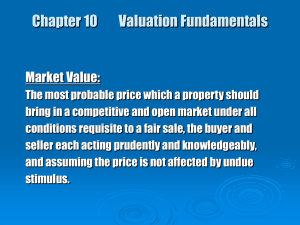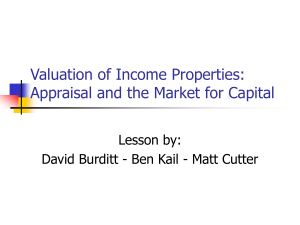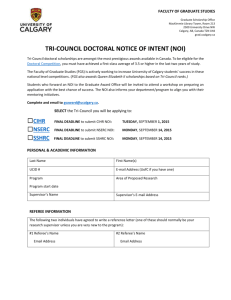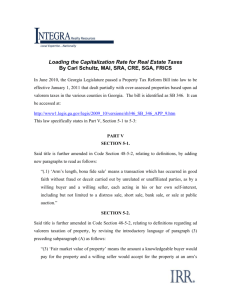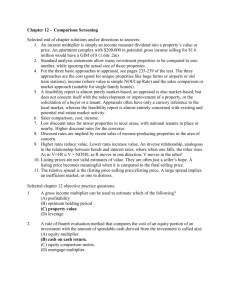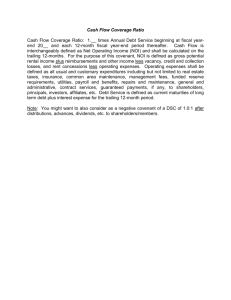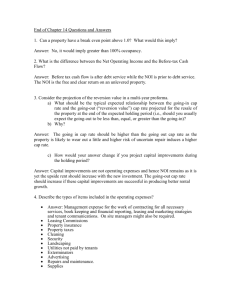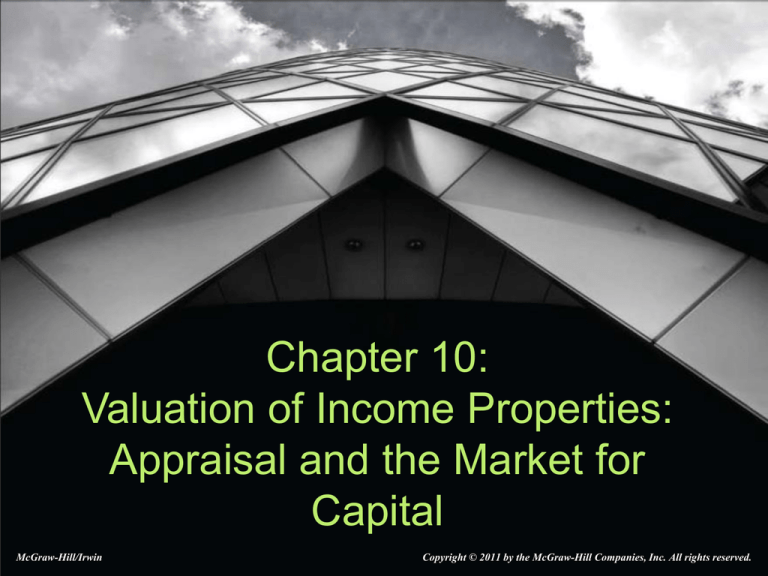
Chapter 10:
Valuation of Income Properties:
Appraisal and the Market for
Capital
McGraw-Hill/Irwin
Copyright © 2011 by the McGraw-Hill Companies, Inc. All rights reserved.
Valuation Fundamentals
Market Value is the most probable price
given the following conditions
– Buyer and seller are typically motivated
– Parties are well informed/well advised and
acting in their best interest
– Reasonable time in the market
– Payment in cash or its equivalent
– Traditional financing
10-2
Appraisal Process
The appraisal process is performed by
appraisers and others seeking to establish
value
– Physical and legal identification
– Identify property rights to be valued
– Specify the purpose of the appraisal
– Specify effective date of value estimate
– Gather and analyze market data
– Apply techniques to estimate value
10-3
Appraisal Process
The Three Approaches
– Sales Comparison Approach
– Income Capitalization Approach
– Cost Approach
For most of this textbook, we will focus on the
income capitalization approach, but the other
two have substantial validity also.
10-4
Sales Comparison Approach
Use data from recently sold “comparables”
to derive a “subject” market value
Adjust comparable sales prices for feature,
age, and size differences, etc.
Lump sum adjustments and square foot
adjustments
Subjective process
10-5
Income Approach
There are three methods for the income
approach.
– Gross Income Multipliers (“GIM”)
– Direct Capitalization Method
– Discount Present Value Method
10-6
Income Approach
1st Income Method: Gross Income Multiplier
(“GIM”)
Sales Price
GIM
Gross Income
Apply GIM to the subject property
Example 10-1: Recent sales of similar property
1
2
3
Sales Price
$600,000 $750,000 $450,000
Gross Income $100,000 $128,000 $74,000
GIM
6x
5.86x
6.08x
10-7
Income Approach
Selecting the GIM from the comparables is
an education opinion
– Which is most similar to the subject?
– How should they be weighted?
– If 6x is determined to be the GIM and the
subject has gross income = $120,000;
Value Estimate = 6 x $120,000 = $720,000
10-8
Income Approach
2nd Income Method: Capitalization Rate
NOI
Value
R
Example 10- 2: Recent similar property sales
1
2
3
4
Sales Price $368,500 $425,000 $310,000 $500,000
NOI
R
$50,000
13.57%
$56,100
13.20%
$42,700
13.77%
$68,600
13.72%
10-9
Income Approach
Capitalization Rate Range:
– 13.20% < R < 13.77%
The cap rate choice is an educated
opinion of the appraiser
– Which property is most similar to the subject?
Note: For any two properties that you
compare, the higher the cap rate, the
lower the value given the same amount of
NOI.
10-10
Income Approach
If the subject NOI = $58,000, the value estimate
could be
– $58,000 < V < $58,000
.1377
.1320
– $421,205 < V < $439,394
Care must be taken when determining R
10-11
Income Approach
Considerations when determining R
Consider the comparables
– Similarity to subject
Physical Attributes
Location
Lease Terms
Operating Efficiency
10-12
Income Approach
Consider the comparables
– How is NOI determined?
Stabilized NOI
Nonrecurring capital outlays
∙ Lump Sum
∙ Averaged
Was NOI skewed by a one-time outlay?
– Depending on the analyst, leasing commissions,
tenant improvements, and recurring capital outlays
may or may not be including in the calculation of net
operating income.
10-13
Income Approach
3rd Income Method: Discounted Present
Value
– Compute the present value of future cash
flows
Forecast NOI
Choose holding period
Select discount rate based on risk and return of
comparable investments (r)
Determine reversion value of property
10-14
Exhibit 10-6
Ten-Year NOI Forecast, Hypothetical Hills Apartments
10-15
Income Approach
Estimating reversion value
– Not an exact science
– Method 1: Discount remaining cash flows
using a terminal cap rate (RT)
RT = (r – g) average long-run growth in NOI is
positive
RT = (r) growth is zero
RT = (r + g) growth is negative
10-16
Income Approach
NOI10
REV 9
r -g
Note that if you are calculating the reversion
at the end of year 9, you use year 10’s NOI
to do so.
10-17
Income Approach
Estimating reversion value
– Method 2: Estimate RT from sales data
5 year holding period for a new property
In general, as properties age, they become less
able to produce income relative to their younger
peers. As a result, the cap rate should be higher
for older properties.
What are current cap rates for 5 year old property?
Use this as the terminal cap rate.
– Method 3: Estimate resale value from
expected changes in property value
10-18
Income Approach
Example 10-3:
– A property has a projected year 1 NOI of
$200,000. NOI is projected to grow by 4%
per year for the following 2 years, then by 2%
per year for the subsequent 2 years at a 1%
constant rate afterward. Given a required
return of 13%, what is the value of the
property?
10-19
Income Approach
Example 10-3:
– NOI1 = $200,000
– NOI2 = $208,000
– NOI3 = $216,320
– NOI4 = $220,646
– NOI5 = $225,059
– Constant 1% growth begins
10-20
Income Approach
Example 10-3:
NOI6 $227,310
Terminal Value 5
r g
.13 .01
= $1,894,250
10-21
Income Approach
Example 10-3:
C0
=0
C1
= $200,000
C2
= $208,000
C3
= $216,320
C4
= $220,646
C5
= $225,059 + $1,894,250
i
= 13
= $1,775,409
CPT
NPV
10-22
Highest & Best Use
Land prices are volatile relative to income
producing real estate.
The land price is determined by its highest
and best use, which is the use that results
in the highest residual land value.
10-23
Highest & Best Use
Residual Land Value
– PV – Building Cost = Land Value
– Step 1: Compute the present value of the
estimated cash flows for all alternatives.
– Step 2: Subtract building cost
– Step 3: Select highest value among the
alternatives
10-24
Mortgage-Equity Capitalization
Property Value = Mortgage Value + Equity
Value
Determining the discount rate to use for
the equity value is challenging
– It should be greater than the discount rate for
the lender.
– It should be higher than the rate of return for
the property.
– It should be competitive when compared to
other investments.
10-25
Valuation Fundamentals
Reconciliation of Value Estimates
– The sales comparison and income
approaches should yield similar value
estimates.
Changing Market Conditions and “Going
in” Cap Rates
– Supply & demand
– Capital markets
– Capital markets & spatial market changes
10-26
Cost Approach
Estimate the construction cost if new
Account for physical deterioration, functional
obsolescence, and/or external obsolescence
Add land cost
Same procedure as was discussed in Chapter 7
The rationale is that no informed buyer would pay more
for a property than it would cost to build a new one. This
assumes, of course, that they took the time to construct
a new asset into account, and the relative risks of ground
up development.
The cost approach is often used for real estate assets
that do not have an efficient market for tenants to lease
space. A common example would be heavy
manufacturing facilities; there is not a deep or broad
market in automobile manufacturing facilities.
10-27

